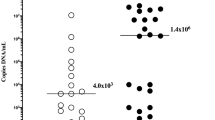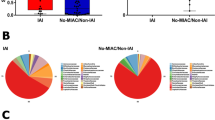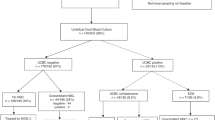Abstract
Objective
We investigated the association between maternal cervicovaginal cultures, its antibiotic treatment, and neonatal outcome.
Study design
This retrospective cohort study enrolled 480 neonates born prior to 32 weeks’ gestation. They were divided into groups according to maternal cervicovaginal culture results. Multivariate logistic regression analysis was used to predict neonatal outcome based on maternal culture results, adjusted for perinatal risk factors and neonatal morbidities.
Result
Maternal cervicovaginal Ureaplasma colonization was independently associated with bronchopulmonary dysplasia at 36 weeks (BPD) (OR 8.34; 95% CI 1.21–57.45). In neonates with and without maternal cervicovaginal Ureaplasma colonization BPD occurred in 12.3% and 3.8%, respectively. Maternal colonization with other microorganisms was associated with a higher neonatal mortality (p = 0.002), lower gestational age (p = 0.026), and birth weight (p = 0.036).
Conclusions
This study underscores the role of the maternal cervicovaginal microbiome as a predictor of neonatal outcome. Cervicovaginal Ureaplasma colonization seems not to be an innocent bystander in the multifactorial etiology of BPD.
This is a preview of subscription content, access via your institution
Access options
Subscribe to this journal
Receive 12 print issues and online access
$259.00 per year
only $21.58 per issue
Buy this article
- Purchase on Springer Link
- Instant access to full article PDF
Prices may be subject to local taxes which are calculated during checkout


Similar content being viewed by others
References
Agbakoba NR, Adetosoye AI, Adewole IF. Presence of mycoplasma and ureaplasma species in the vagina of women of reproductive age. West Afr J Med. 2007;26:28–31.
Donders GG, Ruban K, Bellen G, Petricevic L. Mycoplasma/Ureaplasma infection in pregnancy: to screen or not to screen. J Perinat Med. 2017;45:505–15.
Velemínský M, Tosner J. Relationship of vaginal microflora to PROM, pPROM and the risk of early-onset neonatal sepsis. Neuro Endocrinol Lett. 2008;29:205–21.
Kirchner L, Helmer H, Heinze G, Wald M, Brunbauer M, Weninger M, et al. Amnionitis with Ureaplasma urealyticum or other microbes leads to increased morbidity and prolonged hospitalization in very low birth weight infants. Eur J Obstet Gynecol Reprod Biol. 2007;134:44–50.
Mikołajczyk M, Wirstlein PK, Wróbel M, Mazela J, Chojnacka K, Skrzypezak J. Prediction of short-term newborn infectious morbidity based on maternal characteristics in patients with PPROM and Ureaplasma species infection. Ginekol Pol. 2015;86:685–8.
Abele-Horn M, Peters J, Genzel-Boroviczeny O, Wolff C, Zimmermann A, Gottschling W. Vaginal Ureaplasma urealyticum colonization: influence on pregnancy outcome and neonatal morbidity. Infection. 1997;25:286–91.
Gancia P, Delogu A, Pomero G. Ureaplasma and bronchopulmonary dysplasia. Early Hum Dev. 2014;90:39–41.
Abele-Horn M, Scholz M, Wolff C, Kolben M. High-density vaginal Ureaplasma urealyticum colonization as a risk factor for chorioamnionitis and preterm delivery. Acta Obstet Gynecol Scand. 2000;79:973–8.
Breugelmans M, Vancutsem E, Naessens A, Laubach M, Foulon W. Association of abnormal vaginal flora and Ureaplasma species as risk factors for preterm birth: a cohort study. Acta Obstet Gynecol Scand. 2010;89:256–60.
Aaltone R, Jalava J, Laurikainen E, Kärkkäinen U, Alanen A. Cervical ureaplasma urealyticum colonization: comparison of PCR and culture for its detection and association with preterm birth. Scand J Infect Dis. 2002;34:35–40.
Carey JC, Blackwelder WC, Nugent RP, Matteson MA, Rao AV, Eschenbach DA, et al. Antepartum cultures for Ureaplasma urealyticum are not useful in predicting pregnancy outcome. The Vaginal Infections and Prematurity Study Group. Am J Obstet Gynecol. 1991;164:728–33.
Vogel I, Thorsen P, Hogan VK, Schieve LA, Jacobsson B, Ferre CD. The joint effect of vaginal Ureaplasma urealyticum and bacterial vaginosis on adverse pregnancy outcomes. Acta Obstet Gynecol Scand. 2006;85:778–85.
Lyon A. Chronic lung disease of prematurity. The role of intra-uterine infection. Eur J Peditr. 2000;159:798–802.
Kasper DC, Mechtler TP, Böhm J, Petricevic L, Gleiss A, Spergser J, et al. In utero exposure to Ureaplasma spp. is associated with increased rate of bronchopulmonary dysplasia and intraventricular hemorrhage in preterm infants. J Perinat Med. 2011;39:331–6.
Berger A, Witt A, Haiden N, Kretzer V, Heinze G, Kohlhauser C. Microbial invasion of the amniotic cavity at birth is associated with adverse short-term outcome of preterm infants. J Perinat Med. 2003;31:115–21.
Dammann O, Leviton A. Maternal intrauterine infection, cytokines, and brain damage in the preterm newborn. Pediatr Res. 1997;42:1–8.
Berger A, Witt A, Haiden N, Kaider A, Klebermasz K, Fuiko R, et al. Intrauterine infection with Ureaplasma species is associated with adverse neuromotor outcome at 1 and 2 years adjusted age in preterm infants. J Perinat Med. 2009;37:72–8.
Yoon BH, Romero R, Jun JK, Park KH, Park JD, Ghezzi F, et al. Amniotic fluid cytokines (interleukin-6, tumor necrosis factor-alpha, interleukin-1 beta, and interleukin-8) and the risk for the development of bronchopulmonary dysplasia. Am J Obstet Gynecol. 1997;177:825–30.
Schelonka RL, Katz B, Waites KB, Benjamin DK Jr. Critical appraisal of the role of Ureaplasma in the development of bronchopulmonary dysplasia with meta-analytic techniques. Pediatr Infect Dis J. 2005;24:1033–9.
Jobe A, Bancalari E. Bronchopulmonary dysplasia. Am J Respir Crit Care Med. 2001;163:1723–9.
Baraldi E, Filippone M. Chronic lung disease after premature birth. N Engl J Med. 2007;357:1946–55.
Picarillo AP, Carlo W. Using quality improvement tools to reduce chronic lung disease. Clin Perinatol. 2017;44:701–12.
Jobe AH. Antenatal factors and the development of bronchopulmonary dysplasia. Semin Neonatol. 2003;8:9–17.
Bhandari V, Bizzarro MJ, Shetty A, Zhong X, Page GP, Zhang H, et al. Familial and genetic susceptibility to major neonatal morbidities in preterm twins. Pediatrics. 2006;117:1901–6.
Mercer BM, Miodovnik M, Thurnau GR, Goldenberg RL, Das AF, Ramsey RD, et al. Antibiotic therapy for reduction of infant morbidity after preterm premature rupture of the membranes. A randomized controlled trial. National Institute of Child Health and Human Development Maternal-Fetal Medicine Units Network. JAMA. 1997;278:989–95.
Kenyon SL, Taylor DJ, Tarnow-Mordi W.ORACLE Collaborative Group Broad-spectrum antibiotics for preterm, prelabour rupture of fetal membranes: the ORACLE I randomised trial.Lancet. 2001;357:979–88.
Grigsby PL, Novy MJ, Sadowsky DW, Morgan TK, Long M, Acosta E, et al. Maternal azithromycin therapy for ureaplasma intra-amniotic infection delays preterm delivery and reduces fetal lung injury in a primate model. Am J Obstet Gynecol. 2012;207:475.e1–14.
Vouga M, Greub G, Prod’hom G, Durussel C, Roth-Kleiner M, Vasilevsky S, et al. Treatment of genital mycoplasma in colonized pregnant women in late pregnancy is associated with a lower rate of premature labour and neonatal complications. Clin Microbiol Infect. 2014;20:1074–9.
Kenyon SL, Taylor DJ, Tarnow-Mordi W.ORACLE Collaborative Group Broad-spectrum antibiotics for spontaneous preterm labour: the ORACLE II randomised trial. Lancet. 2001;357:989–94.
Eschenbach DA, Nugent RP, Rao AV, Cotch MF, Gibbs RS, Lipscomb KA.The Vaginal Infections and Prematurity Study Group et al.A randomized placebo-controlled trial of erythromycin for the treatment of Ureaplasma urealyticum to prevent premature delivery.Am J Obstet Gynecol.1991;164:734–42.
Romero R, Hagay Z, Nores J, Sepulveda W, Mazor M. Eradication of Ureaplasma urealyticum from the amniotic fluid with transplacental antibiotic treatment. Am J Obstet Gynecol. 1992;166:618–20.
Kemp MW, Miura Y, Payne MS, Watts R, Megharaj S, Jobe AH, et al. Repeated maternal intramuscular or intraamniotic erythromycin incompletely resolves intrauterine Ureaplasma parvum infection in a sheep model of pregnancy. Am J Obstet Gynecol. 2014;211:134.e1–9.
Miura Y, Payne MS, Keelan JA, Noe A, Carter S, Watts R, et al. Maternal intravenous treatment with either azithromycin or solithromycin clears ureaplasma parvum from the amniotic fluid in an ovine model of intrauterine infection. Antimicrob Agents Chemother. 2014;58:5413–20.
Acosta EP, Grigsby PL, Larson KB, James AM, Long MC, Duffy LB, et al. Transplacental transfer of azithromycin and its use for eradicating intra-amniotic ureaplasma infection in a primate model. J Infect Dis. 2014;209:898–904.
Hipp SS, Rockwood LD, Gaafar HA, Han Y. Evaluation of preservation methods and solid media suitable for recovery of Ureaplasma urealyticum from transported urine specimens. J Clin Microbiol. 1981;13:135–8.
Parry G, Tucker J, Tarnow-Mordi W.UK Neonatal Staffing Study Collaborative Group CRIB II: an update of the clinical risk index for babies score. Lancet. 2003;361:1789–91.
Suzuki Y, Horie K, Yada Y, Kono Y, Hirashima C, Usui R, et al. Vaginal Ureaplasma species increase chorioamnionitis in very preterm infants with preterm premature rupture of the membranes at <28 weeks of gestation. Eur J Clin Microbiol Infect Dis. 2018;37:2371–80.
Hartling L, Liang Y, Lacaze-Masmonteil T. Chorioamnionitis as a risk factor for bronchopulmonary dysplasia: a systematic review and meta-analysis. Arch Dis Child Fetal Neonatal Ed. 2012;97:F8–17.
Kalikkot Thekkeveedu R, Guaman MC, Shivanna B. Bronchopulmonary dysplasia: a review of pathogenesis and pathophysiology. Respir Med. 2017;132:170–7.
Torchin H, Lorthe E, Goffinet F, Kayem G, Subtil D, Truffert P, et al. Histologic chorioamnionitis and bronchopulmonary dysplasia in preterm infants: the epidemiologic study on low gestational ages 2 cohort. J Pediatr. 2017;187:98–104.e3.
Kaneko M, Sato M, Ogasawara K, Imamura T, Hashimoto K, Momoi N, et al. Serum cytokine concentrations, chorioamnionitis and the onset of bronchopulmonary dysplasia in premature infants. J Neonatal Perinat Med. 2017;10:147–55.
Ballard AR, Mallett LH, Pruszynski JE, Cantey JB. Chorioamnionitis and subsequent bronchopulmonary dysplasia in very-low-birth weight infants: a 25-year cohort. J perinatology: Off J Calif Perinat Assoc. 2016;36:1045–8.
Colaizy TT, Morris CD, Lapidus J, Sklar RS, Pillers DA. Detection of ureaplasma DNA in endotracheal samples is associated with bronchopulmonary dysplasia after adjustment for multiple risk factors. Pediatr Res. 2007;61:578–83.
Wang EE, Ohlsson A, Kellner JD. Association of Ureaplasma urealyticum colonization with chronic lung disease of prematurity: results of a metaanalysis. J Pediatr. 1995;127:640–4.
Biernat-Sudolska M, Rojek-Zakrzewska D, Lauterbach R. Assessment of various diagnostic methods of ureaplasma respiratory tract infections in newborns. Acta Biochim Pol. 2006;53:609–11.
Yoon BH, Romero R, Kim M, Kim EC, Kim T, Park JS, et al. Clinical implications of detection of Ureaplasma urealyticum in the amniotic cavity with the polymerase chain reaction. Am J Obstet Gynecol. 2000;183:1130–7.
Lowe J, Watkins WJ, Edwards MO, Spiller OB, Jacqz-Aigrain E, Kotecha SJ, et al. Association between pulmonary ureaplasma colonization and bronchopulmonary dysplasia in preterm infants: updated systematic review and meta-analysis. Pediatr Infect Dis J. 2014;33:697–702.
Romero R, Miranda J, Chaiworapongsa T, Chaemsaithong P, Gotsch F, Dong Z, et al. Sterile intra-amniotic inflammation in asymptomatic patients with a sonographic short cervix: prevalence and clinical significance. J Matern Fetal Neonatal Med. 2015;28:1343–59.
Baud O, Maury L, Lebail F, Ramful D, El Moussawi F, Nicaise C, et al. Effect of early low-dose hydrocortisone on survival without bronchopulmonary dysplasia in extremely preterm infants (PREMILOC): a double-blind, placebo-controlled, multicentre, randomised trial. Lancet. 2016;387:1827–36.
Nair V, Loganathan P, Soraisham AS. Azithromycin and other macrolides for prevention of bronchopulmonary dysplasia: a systematic review and meta-analysis. Neonatology. 2014;106:337–47.
Ballard HO, Shook LA, Bernard P, Anstead MI, Kuhn R, Whitehead V, et al. Use of azithromycin for the prevention of bronchopulmonary dysplasia in preterm infants: a randomized, double-blind, placebo controlled trial. Pediatr Pulmonol. 2011;46:111–8.
Ozdemir R, Erdeve O, Dizdar EA, Oguz SS, Uras N, Saygan S, et al. Clarithromycin in preventing bronchopulmonary dysplasia in Ureaplasma urealyticum-positive preterm infants. Pediatrics. 2011;128:e1496–501.
Keelan JA, Nitsos I, Saito M, Musk GC, Kemp MW, Timmins M, et al. Maternal-amniotic-fetal distribution of macrolide antibiotics following intravenous, intramuscular, and intraamniotic administration in late pregnant sheep. Am J Obstet Gynecol. 2011;204:546.e10–7.
Kim SM, Romero R, Lee J, Chaemsaithong P, Docheva N, Yoon BH. Gastric fluid versus amniotic fluid analysis for the identification of intra-amniotic infection due to Ureaplasma species. J Matern Fetal Neonatal Med. 2016;29:2579–87.
Harada K, Tanaka H, Komori S, Tsuji Y, Nagata K, Tsutsui H, et al. Vaginal infection with Ureaplasma urealyticum accounts for preterm delivery via induction of inflammatory responses. Microbiol Immunol. 2008;52:297–304.
Sanchez-Garcia EK, Contreras-Paredes A, Martinez-Abundis E, Garcia-Chan D, Lizano M, de la Cruz-Hernandez E. Molecular epidemiology of bacterial vaginosis and its association with genital micro-organisms in asymptomatic women. J Med Microbiol. 2019;68:1373–82.
Snyder CC, Wolfe KB, Gisslen T, Knox CL, Kemp MW, Kramer BW, et al. Modulation of lipopolysaccharide-induced chorioamnionitis by Ureaplasma parvum in sheep. Am J Obstet Gynecol. 2013;208:399.e1–8.
Silwedel C, Speer CP, Haarmann A, Fehrholz M, Claus H, Schlegel N, et al. Ureaplasma species modulate cytokine and chemokine responses in human brain microvascular endothelial cells. Int J Mol Sci. 2019;20:3583.
Manimtim WM, Hasday JD, Hester L, Fairchild KD, Lovchik JC, Viscardi RM. Ureaplasma urealyticum modulates endotoxin-induced cytokine release by human monocytes derived from preterm and term newborns and adults. Infect Immun. 2001;69:3906–15.
Sung TJ, Xiao L, Duffy L, Waites KB, Chesko KL, Viscardi RM. Frequency of ureaplasma serovars in respiratory secretions of preterm infants at risk for bronchopulmonary dysplasia. Pediatr Infect Dis J. 2011;30:379–83.
Kemp MW, Ahmed S, Beeton ML, Payne MS, Saito M, Miura Y, et al. Foetal Ureaplasma parvum bacteraemia as a function of gestation-dependent complement insufficiency: evidence from a sheep model of pregnancy. Am J Reprod Immunol. 2016;00:1–9.
Baizat M, Zaharie G, Iancu M, Muresan D, Hășmășanu M, Procopciuc LM. Potential clinical predictors of suspected early and late onset sepsis (eos and los) in preterm newborns: a single tertiary center retrospective study. Clin Lab. 2019;65:7.
Yudin MH, Money DM. Screening and management of bacterial vaginosis in pregnancy. J Obstet Gynaecol Can. 2017;39:e184–91.
Pavlidis I, Spiller OB, Sammut Demarco G, MacPherson H, Howie SEM, Norman JE, et al. Cervical epithelial damage promotes Ureaplasma parvum ascending infection, intrauterine inflammation and preterm birth induction in mice. Nat Commun. 2020;11:199.
Kwak DW, Hwang HS, Kwon JY, Park YW, Kim YH. Co-infection with vaginal Ureaplasma urealyticum and Mycoplasma hominis increases adverse pregnancy outcomes in patients with preterm labor or preterm premature rupture of membranes. J Matern Fetal Neonatal Med. 2014;27:333–7.
Donders GG, Van Calsteren K, Bellen G, Reybrouck R, Van den Bosch T, Riphagen I, et al. Predictive value for preterm birth of abnormal vaginal flora, bacterial vaginosis and aerobic vaginitis during the first trimester of pregnancy. Br J Obstet Gynaecol. 2009;116:1315–24.
Hassan MF, Rund NMA, El-Tohamy O, Moussa M, Ali YZ, Moussa N, et al. Does aerobic vaginitis have adverse pregnancy outcomes? Prospective observational study. Infect Dis Obstet Gynecol. 2020;2020:5842150.
Author information
Authors and Affiliations
Corresponding author
Ethics declarations
Conflict of interest
The authors declare no conflict of interest.
Additional information
Publisher’s note Springer Nature remains neutral with regard to jurisdictional claims in published maps and institutional affiliations.
Supplementary information
Rights and permissions
About this article
Cite this article
Van Mechelen, K., Meeus, M., Matheeussen, V. et al. Association between maternal cervicovaginal swab positivity for Ureaplasma spp. or other microorganisms and neonatal respiratory outcome and mortality. J Perinatol 41, 1–11 (2021). https://doi.org/10.1038/s41372-020-00808-7
Received:
Revised:
Accepted:
Published:
Issue Date:
DOI: https://doi.org/10.1038/s41372-020-00808-7
This article is cited by
-
Maternal Ureaplasma exposure during pregnancy and the risk of preterm birth and BPD: a meta-analysis
Archives of Gynecology and Obstetrics (2022)



